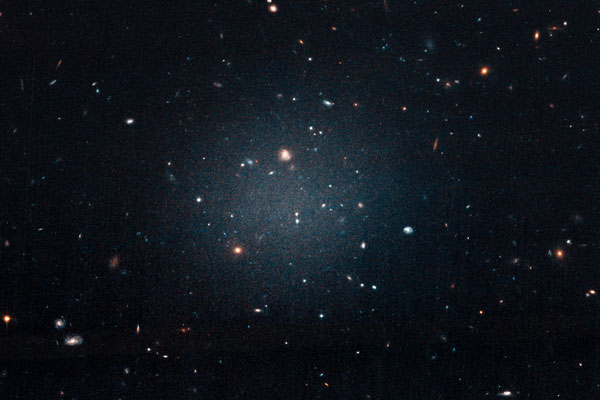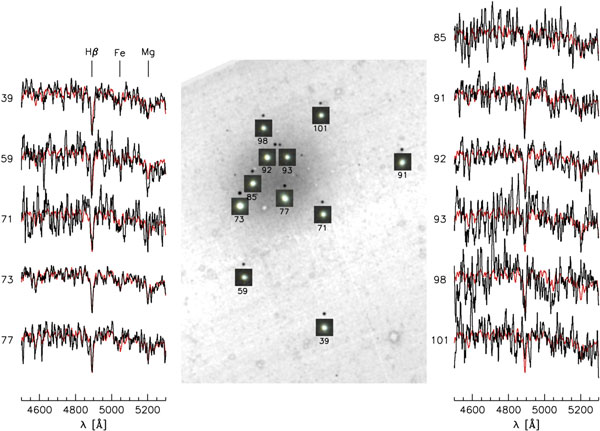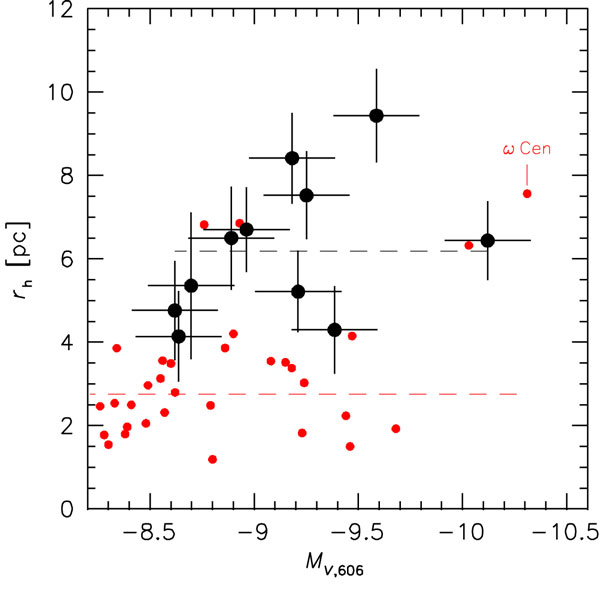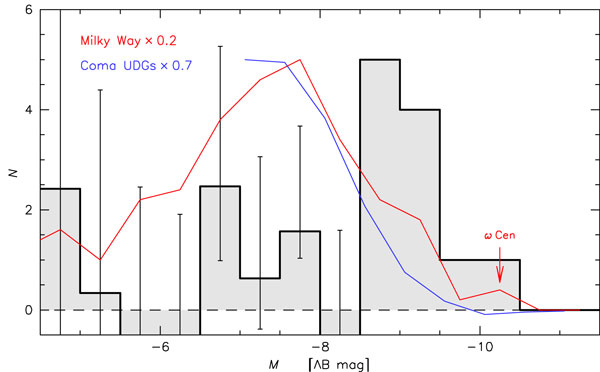You may have seen recent news about NGC 1052–DF2, a galaxy that was discovered to have little or no dark matter. Now, a new study explores what NGC 1052–DF2 does have: an enigmatic population of unusually large and luminous globular clusters.

NASA/ESA/P. van Dokkum (Yale University)
An Unusual Dwarf

van Dokkum et al. 2018
The ultra-diffuse galaxy NGC 1052–DF2, originally identified with the Dragonfly Telescope Array, has puzzled astronomers since the discovery that its dynamical mass — determined by the motions of globular-cluster-like objects spotted within it — is essentially the same as its stellar mass. This equivalence implies that the galaxy is strangely lacking dark matter; the upper limit set on its dark matter halo is 400 times smaller than what we would expect for such a dwarf galaxy.
Led by Pieter van Dokkum (Yale University), the team that made this discovery has now followed up with detailed Hubble Space Telescope imaging and Keck spectroscopy. Their goal? To explore the objects that allowed them to make the dynamical-mass measurement: the oddly bright globular clusters of NGC 1052–DF2.
What’s Up with the Globular Clusters?

Adapted from van Dokkum et al. 2018
Van Dokkum and collaborators spectroscopically confirmed 11 compact objects associated with the faint galaxy. These objects are globular-cluster-like in their appearance, but the peak of their luminosity distribution is offset by a factor of four from globular clusters of other galaxies; these globular clusters are significantlybrighter than is typical.
Using the Hubble imaging, the authors determined that NGC 1052–DF2’s globular clusters are more than twice the size of the Milky Way’s globular clusters in the same luminosity range. As is typical for globular clusters, they are an old (~9.3 billion years) population and metal-poor.
Rethinking Formation Theories
The long-standing picture of galaxies has closely connected old, metal-poor globular clusters to the galaxies’ dark-matter halos. Past studies have found that the ratio between the total globular-cluster mass and the overall mass of a galaxy (i.e., all dark + baryonic matter) holds remarkably constant across galaxies — it’s typically ~3 x 10-5. This has led researchers to believe that properties of the dark-matter halo may determine globular-cluster formation.

Adapted from van Dokkum et al. 2018
NGC 1052–DF2, with a globular-cluster mass that’s >3% of the mass of the galaxy (~1000 times the expected ratio!), defies this picture. This unusual galaxy therefore demonstrates that the usual relation between globular-cluster mass and total galaxy mass probably isn’t due to a fundamental connection between the dark-matter halo and globular-cluster formation. Instead, van Dokkum and collaborators suggest, globular-cluster formation may ultimately be a baryon-driven process.
As with all unexpected discoveries in astronomy, we must now determine whether NGC 1052–DF2 is simply a fluke, or whether it represents a new class of object we can expect to find more of. Either way, this unusual galaxy is forcing us to rethink what we know about galaxies and the star clusters they host.
Citation
Pieter van Dokkum et al 2018 ApJL 856 L30. doi:10.3847/2041-8213/aab60b
Related Journal Articles
This post originally appeared on AAS Nova, which features research highlights from the journals of the American Astronomical Society.
 4
4









Comments
Hendrik
April 13, 2018 at 4:39 pm
This article states that: "The ultra-diffuse galaxy NGC 1052–DF2, originally identified with the Dragonfly Telescope Array..."
In a previous article (http://skyandtelescope.org/astronomy-news/a-galaxy-without-much-dark-matter/) it says: "Astronomers already knew DF2 existed, as it showed up as a collection of dots in survey images.".
According to HyperLeda NGC1052-DF was known as PGC3097693 (http://leda.univ-lyon1.fr/ledacat.cgi?o=PGC3097693). Principal Galaxy Catalog (PGC) from 2003.
http://simbad.u-strasbg.fr/simbad/sim-id?Ident=PGC3097693&NbIdent=1&Radius=2&Radius.unit=arcmin&submit=submit+id the galaxy is barely visible on the DSS image.
Hendrik
You must be logged in to post a comment.
Monica Young
April 17, 2018 at 12:07 pm
Hi Hendrik - I believe the point that the authors at AAS Nova were making is that the galaxy was not identified as an ultra-diffuse galaxy until the Dragonfly images were taken.
You must be logged in to post a comment.
JoeBakhos
April 17, 2018 at 8:46 pm
I think that at a certain galactic distance, gravity reverses and the galaxies begin pushing against each other. This would do away with cosmological expansion, dark matter, and dark energy. This is a claim that can be easily tested:
A revised gravity equation looks like this (I have made an adjustment compared to my last version):
F = (1.047 X 10^-17) m1m2 [-cos(Θ)] / r^2 where tan Θ = r / (1.419 X 10^22)
In my Reddit article linked below I explain the math behind reasoning why gravity might behave in this strange way. Please do not dismiss the idea until you see the justification. By playing with the constants, this equation can be fitted and tested against the data of galactic motion. It means that at a certain distance, gravity will reverse and the galaxies will be pushing against each other. This pressure against each other does away with the need for dark matter or dark energy in cosmology.
So the equation can be tested against current data to see if it fits. This equation also predicts that galaxies near the edge of the universe will be deformed — concave with the concavity pointing towards the center of the universe.
This equation also predicts the existence of isolated galaxies that are far away from other galaxies, that would behave normally without the need to posit dark matter. An example of this type of galaxy is NGC1052–DF2 . Talked about in this article:
https://www.nature.com/articles/nature25767
So what I am asking is very precise, very narrow, very testable: Someone please test this equation to see if slight adjustment of the constants will account for galactic motion or not. If it does, then proceed to the rest of the theory.
If it cannot, then the theory can be dismissed. Either way, I would like to know — but I would not be convinced with a simple “absurd!” or dismissal unless it has been tested out.
If it is true that the motion of galaxies can be modeled in this way, I would ask that you take a look at the explanation in this theory:
https://www.reddit.com/r/MyTheoryIs/comments/87pcgq/what_dark_matter_is/
You must be logged in to post a comment.
Peter Wilson
April 22, 2018 at 11:31 am
1.419 X 10^22 what?!? Meters? Miles? Fathoms?
You must be logged in to post a comment.
You must be logged in to post a comment.